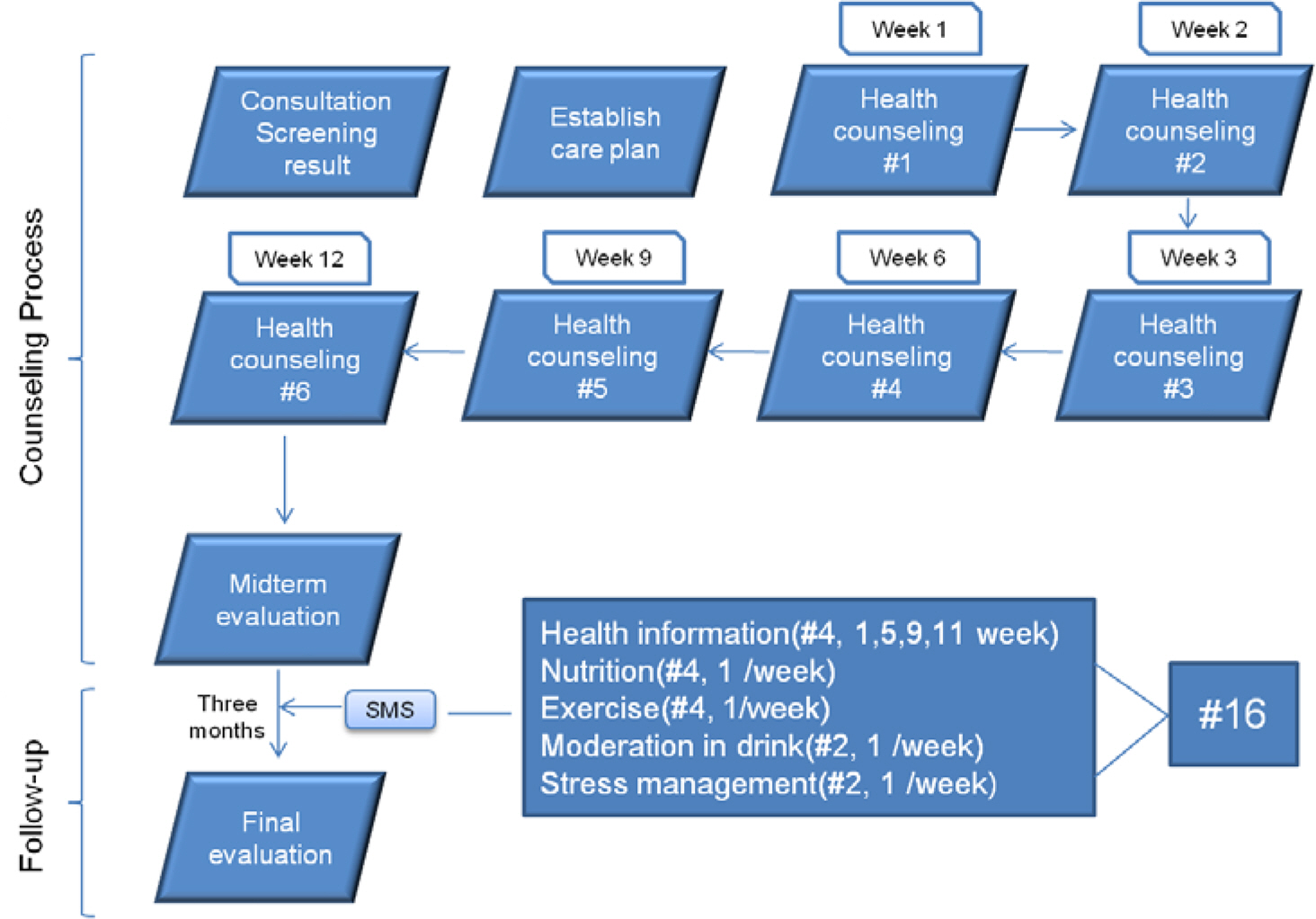Korean J Adult Nurs.
2013 Jun;25(3):241-249.
Effects of Health Education using Short Messaging Service of Cellular Phone
- Affiliations
-
- 1Department of Nursing, Gimcheon University, Gimcheon, Korea. hyunkim@gimcheon.ac.kr
Abstract
- PURPOSE
The aim of the study was to identify the effects of education from using cellular phones and a short messaging service.
METHODS
Collected data included baseline demographics, blood pressure, abdominal circumference, total cholesterol, body mass index and health behavior index (Dietary Practice Guidelines Score, Physical Activity, Drinking frequency, Stress score, Subjective health status, and Action change stage score). Data were collected at public health centers in Chungcheongnam-do from January to December, 2011. Data obtained from Individual health counseling Programs in Chungcheongnam-do. Analysis was divided into health risk group and Disease management group, using a paired t test.
RESULTS
Following the education of using short messaging service of cellular phones Health risk group was a reduction in the systolic blood pressure, diastolic blood pressure, waist circumference. Disease management group was a reduction in the systolic blood pressure and body mass index. In both groups, there were improvement in the Health behavior index; dietary practice guidelines score, physical activity, stress score, subjective health status and action change stage scores.
CONCLUSION
These results indicated that education using short messaging service of cellular phone for Community was effective in improving health behaviors and status. By applying the results, development of customized teaching messages for stable settlement is required.
MeSH Terms
Figure
Reference
-
Beverly B. G.., Timothy M.., Michael H.., Madsen L.., Madlen C.., Diana B.2002. Effectiveness of telephone support in Increasing physical activity levels in primary care patient. American Journal of Preventive Medicine. 22(3):177–183.Chang S. O.., Kim E. J.., Kil S. Y.., Seomun G. A.., Lee S. J.2005. Influential variables on intention and action to quit smoking between adolescent smokers and adult smokersbased on the transtheoretical model. Journal of the Korean Academy of Nursing. 35:1410–1419.
ArticleBramley D.., Riddell T.., Whittaker R.., Corbett T.., Lin R. B.., Wills M., et al. 2005. Smoking cessation using mobile phone text messaging is as effective in Maori as non-Maori. The New Zealand Medical Journal. 118(1216):1–10.Faul F.., Erdfelder E.., Lang A. G.., Buchner A.2009. Statistical power analyses using G∗ Power 3.1: Tests for correlation and regression analyses. Behavior Research Methods. 41(4):1149–1160.Ferrini R. L.., Edelstein S.., Barrett-Connor E.1994. The association between health beliefs and health behavior change in older adults. Preventive Medicine. 23(1):1–5.
ArticleHaapala I.., Barengo N. C.., Biggs S.., Surakka L.., Manninen P.2009. Weight loss by mobile phone: A 1-year effectiveness study. Public Health Nutrition. 12(12):2382–2391.
ArticleHurling R.., Catt M.., DeBoni M.., Fairley W.., Hurst T.., Murray P., et al. 2007. Using Internet and mobile phone technology to deliver an automated physical activity program: Randomized controlled trial. Journal of Medicine Internet Research. 9(2):1–13.
ArticleJoo N. S.., Kim B. T.2007. Mobile phone short message service messaging for behaviour modification in a community-based weight control programme in Korea. Journal of Tele-medicine and Telecare. 13:416–420.
ArticleKim H.., Lee S. G.2012. Effects of an individual health counseling program for community. Korean Journal of Health Education Promotion. 29(2):13–21.Kim H. S.2003. Fasting blood sugar and adherence to diabetes control recommendation: Impact of education using short messaging service of cellular phone. The Korean Journal of Fundamentals of Nursing. 5(2):13–19.Kim H. S.., Park H. J.2006. Effects of a nurse short-message service via cellular phones for people with diabetes. The Korean Journal of Fundamentals of Nursing. 13(2):235–241.Kuntsche E.., Robert B.2009. Short message service technology in alcohol research. Alcohol & Alcoholism. 44(4):423–428.Lee Y. R.., Kim M. J.2009. A transition of health habits and self-rated health status of women aged in early adulthood. Journal of Korean Academy of Public Health Nursing. 23(2):199–206.Marquez C. E.., Figuera W. M.., Guillen V.., Figueras M.., Balana M.., Maval J.2004. Effectiveness of an intervention to provide information to patients with hypertension as short text messages of reminders sent to their mobile phone. Atencion Primaria. 34(8):399–405.Meloche J.2003. Cooking with class: Participation soars with hands-on learning and take-aways. Journal of Nutrition Education Behavior. 35(2):107.
ArticleMinistry of Health and Welfare. 2005. Handbook of health promotion. Seoul, Korea: Author.Ministry of Health and Welfare. 2009. Handbook of health promotion. Seoul, Korea: Author.Ministry of Health and Welfare. 2011. Guideline of health promotion for community. Seoul, Korea: Author.Nam J. G.2000. Health educations strategy for local health department. Journal of Korean Society for Health Education and Promotion. 17(1):171–184.Park S. Y.., Yang Y. J.., Kim Y. R.2011. Effects of nutrition education using a ubiquitous healthcare(u-health) service on metabolic syndrome in male workers. The Korean Journal Nutrition. 44(3):231–242.Oh H. S.., Jang M.., Hwang M. O.., Cho S. W.., Paek Y. M.., Choi T. I., et al. 2009. Effect of 1 year E-mail nutrition education after face to face encounter at worksite: Changes in cardiovascular risk factors. The Korean Journal Nutrition. 42(6):559–566.Yang J. G.2009. Effects of nutrition education program for elderly with hypertension at the public health center: Focused on individual energy intake. Unpublished master thesis, Jeonbuk university, Jeonju.Yoon K. H.., Kim H. S.2008. A short message service by cellular phone in type2. Diabetes Research and Clinical Practice. 79:256–261.
- Full Text Links
- Actions
-
Cited
- CITED
-
- Close
- Share
- Similar articles
-
- Effects of a Nurse Short-Message Service via Cellular Phones for People with Diabetes
- Educational Needs for Prevention of Cell Phone Addiction in Korean Adolescents
- Effects of Internet-based Diabetic Education on Plasma Glucose and Serum Lipids in Female Type 2 Diabetic Patients
- Effects of Web-based Health Education on Blood Glucose and Blood Pressure Improvement in Postmenopausal Women with Impaired Fasting Blood Glucose
- Comparison of the Effects of Internet Diabetes Education by Gender in Type 2 Diabetic Patients


